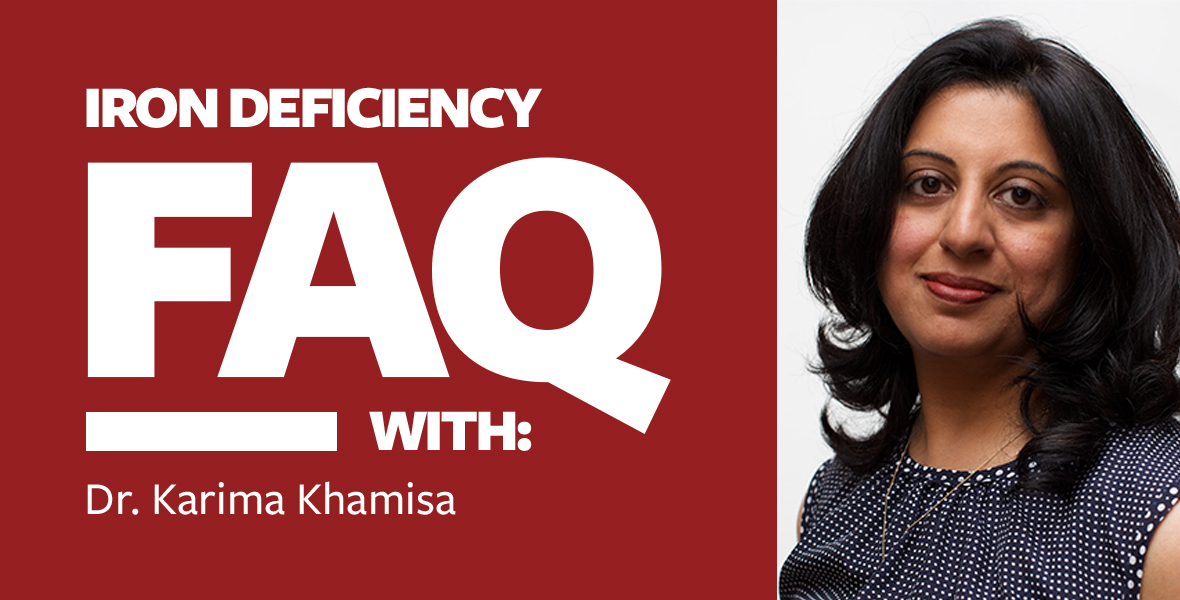Iron Deficiency
Explore the various frequently asked questions below concerning topics relevant to people already diagnosed with a bleeding disorder. Also feel free to download or print the resource. Special thanks to Dr. Karima Khamisa for providing the information for the FAQs.
- What is anemia? What are the symptoms of anemia?
- What is iron deficiency anemia? What are the causes?
- How common is iron deficiency (with or without anemia in women with heavy menstrual bleeding)?
- How is iron deficiency diagnosed?
- How is iron deficiency managed?
- What are the side effects of iron supplements?
- What happens if iron supplements give me too many side effects?
- What are other resources to help me learn more?
About the author
Dr. Karima Khamisa is a hematologist and assistant professor at the University of Ottawa. Dr. Khamisa obtained her MD degree at The University of Western Ontario and completed a fellowship in Internal Medicine at Queens University, followed by a hematology fellowship at the University of Ottawa. She is the current haematology content expert for undergraduate curriculum at the University of Ottawa. She has published in the area of medical education and clinical hematology.
Anemia refers to the lack of red blood cells in the body, indicated by a low level of a protein in red blood cells called hemoglobin. Symptoms of low hemoglobin (and anemia) include pale skin, fatigue, light headedness, poor exercise tolerance, headaches and cold hands and feet. In severe cases of anemia, patients may have a heart attack or stroke.
A key component of hemoglobin is iron. Without enough iron, patients can have a low hemoglobin. The most common cause of anemia worldwide is iron deficiency. Iron is a part of many foods – particularly meat, seafood and certain vegetables. Poor dietary intake can cause low iron. In Canada, iron deficiency is commonly caused by bleeding – usually heavy menstrual bleeding and/or bowel bleeding. Children undergoing rapid growth or pregnant women are also susceptible to iron deficiency.
According to a recently published gynecology journal, up to 63 % of women with heavy menstrual bleeding suffer from iron deficiency.
Iron deficiency anemia can be diagnosed with two blood tests – the CBC (complete blood count) and a ferritin (iron) level. Additional iron studies may be helpful in some cases.
The key to managing iron deficiency is by diagnosing and treating the underlying cause. If the underlying cause is heavy menstrual bleeding, speak to your physician about medications or treatments to help reduce menstrual flow. If poor iron intake is the issue, try to include more iron rich foods in your diet.
If you have significant iron deficiency anemia, dietary measures alone usually aren’t effective. You may need to take an oral iron supplement (usually a liquid or pill). Most oral iron supplements are available at your pharmacy without a prescription. Typically you would need to take 100 mg of elemental iron a day to treat iron deficiency anemia. Most patients remain on oral iron supplements for at least 3 months, however, longer treatments may be needed if there are ongoing bleeding symptoms. Ensuring a diet rich in Vitamin C or taking Vitamin C supplements can help with iron absorption. It is important to follow your hemoglobin and iron levels regularly while on oral iron supplements. Speak with your health care provider to determine what iron supplement is right for you and arrange follow up bloodwork while on iron.
Iron supplements can cause constipation, dark green stool and nausea. You may need to increase your water intake and fibre content while taking oral iron.
Speak with your doctor about your side effects. If you have persistent iron deficiency anemia, you may need an infusion of intravenous iron, usually given at a hospital. This is reserved for patients with a low hemoglobin who do not respond to or tolerate oral iron supplements.










